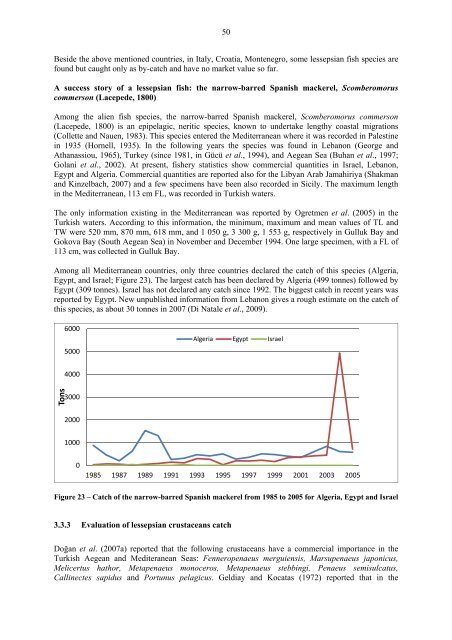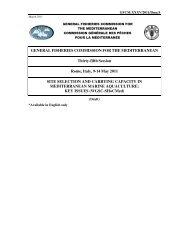Status of alien species in the Mediterranean and Black Sea
Status of alien species in the Mediterranean and Black Sea
Status of alien species in the Mediterranean and Black Sea
Create successful ePaper yourself
Turn your PDF publications into a flip-book with our unique Google optimized e-Paper software.
50<br />
Beside <strong>the</strong> above mentioned countries, <strong>in</strong> Italy, Croatia, Montenegro, some lessepsian fish <strong>species</strong> are<br />
found but caught only as by-catch <strong>and</strong> have no market value so far.<br />
A success story <strong>of</strong> a lessepsian fish: <strong>the</strong> narrow-barred Spanish mackerel, Scomberomorus<br />
commerson (Lacepede, 1800)<br />
Among <strong>the</strong> <strong>alien</strong> fish <strong>species</strong>, <strong>the</strong> narrow-barred Spanish mackerel, Scomberomorus commerson<br />
(Lacepede, 1800) is an epipelagic, neritic <strong>species</strong>, known to undertake lengthy coastal migrations<br />
(Collette <strong>and</strong> Nauen, 1983). This <strong>species</strong> entered <strong>the</strong> <strong>Mediterranean</strong> where it was recorded <strong>in</strong> Palest<strong>in</strong>e<br />
<strong>in</strong> 1935 (Hornell, 1935). In <strong>the</strong> follow<strong>in</strong>g years <strong>the</strong> <strong>species</strong> was found <strong>in</strong> Lebanon (George <strong>and</strong><br />
Athanassiou, 1965), Turkey (s<strong>in</strong>ce 1981, <strong>in</strong> Gücü et al., 1994), <strong>and</strong> Aegean <strong>Sea</strong> (Buhan et al., 1997;<br />
Golani et al., 2002). At present, fishery statistics show commercial quantities <strong>in</strong> Israel, Lebanon,<br />
Egypt <strong>and</strong> Algeria. Commercial quantities are reported also for <strong>the</strong> Libyan Arab Jamahiriya (Shakman<br />
<strong>and</strong> K<strong>in</strong>zelbach, 2007) <strong>and</strong> a few specimens have been also recorded <strong>in</strong> Sicily. The maximum length<br />
<strong>in</strong> <strong>the</strong> <strong>Mediterranean</strong>, 113 cm FL, was recorded <strong>in</strong> Turkish waters.<br />
The only <strong>in</strong>formation exist<strong>in</strong>g <strong>in</strong> <strong>the</strong> <strong>Mediterranean</strong> was reported by Ogretmen et al. (2005) <strong>in</strong> <strong>the</strong><br />
Turkish waters. Accord<strong>in</strong>g to this <strong>in</strong>formation, <strong>the</strong> m<strong>in</strong>imum, maximum <strong>and</strong> mean values <strong>of</strong> TL <strong>and</strong><br />
TW were 520 mm, 870 mm, 618 mm, <strong>and</strong> 1 050 g, 3 300 g, 1 553 g, respectively <strong>in</strong> Gulluk Bay <strong>and</strong><br />
Gokova Bay (South Aegean <strong>Sea</strong>) <strong>in</strong> November <strong>and</strong> December 1994. One large specimen, with a FL <strong>of</strong><br />
113 cm, was collected <strong>in</strong> Gulluk Bay.<br />
Among all <strong>Mediterranean</strong> countries, only three countries declared <strong>the</strong> catch <strong>of</strong> this <strong>species</strong> (Algeria,<br />
Egypt, <strong>and</strong> Israel; Figure 23). The largest catch has been declared by Algeria (499 tonnes) followed by<br />
Egypt (309 tonnes). Israel has not declared any catch s<strong>in</strong>ce 1992. The biggest catch <strong>in</strong> recent years was<br />
reported by Egypt. New unpublished <strong>in</strong>formation from Lebanon gives a rough estimate on <strong>the</strong> catch <strong>of</strong><br />
this <strong>species</strong>, as about 30 tonnes <strong>in</strong> 2007 (Di Natale et al., 2009).<br />
Tons<br />
6000<br />
5000<br />
4000<br />
3000<br />
2000<br />
1000<br />
0<br />
1985 1987 1989 1991 1993 1995 1997 1999 2001 2003 2005<br />
Figure 23 – Catch <strong>of</strong> <strong>the</strong> narrow-barred Spanish mackerel from 1985 to 2005 for Algeria, Egypt <strong>and</strong> Israel<br />
3.3.3 Evaluation <strong>of</strong> lessepsian crustaceans catch<br />
Algeria Egypt Israel<br />
Doğan et al. (2007a) reported that <strong>the</strong> follow<strong>in</strong>g crustaceans have a commercial importance <strong>in</strong> <strong>the</strong><br />
Turkish Aegean <strong>and</strong> Mediteranean <strong>Sea</strong>s: Fenneropenaeus merguiensis, Marsupenaeus japonicus,<br />
Melicertus hathor, Metapenaeus monoceros, Metapenaeus stebb<strong>in</strong>gi, Penaeus semisulcatus,<br />
Call<strong>in</strong>ectes sapidus <strong>and</strong> Portunus pelagicus. Geldiay <strong>and</strong> Kocatas (1972) reported that <strong>in</strong> <strong>the</strong>
















